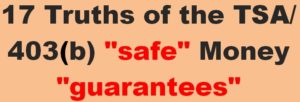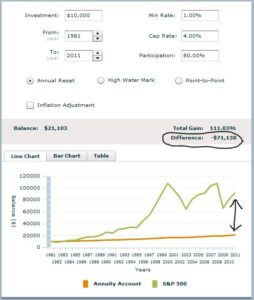Tax-sheltered Annuity’s (TSA) Long, Sordid, and Lucrative Sales History with the Public PreK-12 Educational Culture
Since 1961 in California, the Tax-sheltered Annuity (TSA) retirement plan has had runaway sales in the billions of dollars to a very specific clientele: public school PreKindergarten-12th grade educators. Public school employees are familiar with the “TSA” label, which has been permanently established in the educational culture as books and pencils are to students.
Why has the sale of this inappropriate and costly product been so successful for 62 years and counting!?
First, a little history:
- From 1961 to 1974, the TSA was the only product available. Since 1974 low-cost mutual funds have been available, but few educators know about them. Even in 2023, insurance agents mislead teachers into thinking that the costly indexed, fixed, or variable annuities are the only product available.
- Over the decades, the TSA sales force has been everywhere and has made friends with tens of thousands of teachers, cafeteria workers, office managers, plant managers, union officers, custodians, principals, and even elected school board members. Never underestimate how powerful and convincing these agents are. They’re EXPERTS in sales and networking with anybody that will listen. But after an annuity sale to you by getting your signature, they disappear quicker than a meteor burning out in the night time sky.
- Educators might feel obligated to sign up for the TSA as the nice salesperson is doing something important and went to the trouble finding teachers in their classroom for “free.” Many principals think they are doing a good thing for their teachers when they allow the salespeople to make presentations after professional development meetings and offer free refreshments.
- Some TSA salespeople are often a teacher moonlighting, an ex-teacher, and/or a family member is a teacher.
- The salesforce makes it convenient to enroll: in classrooms, parking lots, district-sponsored curriculum training sessions, PD, cafeterias, home, or union hall.
- Educators are sometimes led to believe the compelling tax-deferred feature is provided by the insurance company. NO! It’s the IRS that provides the tax-deferred benefit. Private companies can never do this.
- Trust has been established as the money contributed will never suffer stock market losses, while the sales pitch claims it earns a guaranteed 3% or 4%. Never believe what is verbally said to you. If you check the contract, it is often too complicated to understand. The best way is to avoid retirement insurance products.
- Some state insurance laws mandate that school districts must make all vendors available who sign the required agreements (California is one of these states). In this strange 403(b) world, districts cannot select the lowest-cost vendors without lawsuit threats (I kid you not!) as they do with other products, such as textbook publishers and computer equipment distributors. Don’t you think Apple or book publishing companies would love a free rein with agents roaming schools too?
- Insurance companies have been in the business of selling safety and peace of mind. Billions of dollars in sales are completed because educators believe their money is safe. According to surveys, losing money is scarier than death! (Click here).
- Psychology trumps a basic economic decision. All of the above history and familiarity make the TSA salesperson so connected with the teaching profession that trust and “safety” of their retirement products have not been questioned in any organized and public manner.
Nothing Wrong with Peace of Mind and Safety! BUT….
Who doesn’t want “peace of mind?” Of course, we all do. Since the Chinese in the 3rd millennia BC created insurance, civilizations have long depended on some form of insurance for safety and peace of mind. Today, without question, we insure our property, autos, and health against losses.
The insurance industry is now piggybacking its historical reputation in a new area where it has done more harm than good to our pocketbooks–long-term retirement plans. Insurance of this type is not needed, too costly, and a TSA will not keep pace with inflation. Its intent is to make you feel safe while your investments are not safe from the ravaging costs of inflation. So, it is not wise to mix insurance with investments–the economic argument against annuities has been long established (Click here for an outstanding article).
To grow your 403(b) to meet or beat the inflation rate, a quality retirement plan takes a modicum of managed risk in the stock and bond market. The stock market can be your friend!
Get ready for some investing basics. I think you will be delighted, empowered, and freed from this cruel hoax of “safe” and “guaranteed” retirement products.
- Nobody wants to lose money. I invest in the stock and bond market, and I don’t want to lose money either! I find the sales pitch about not losing money ironic and disingenuous because it’s not just educators who don’t want to lose money. With a basic understanding of how investing in a portfolio of low-cost index stock funds works in your best interest, we can achieve genuine safety and more money for retirement. Financial Independence is the ultimate safety net! (Click HERE to see my current portfolio of low-cost index funds, both stocks, and bonds).
- Teachers are not informed of all 403(b) or 457(b) options. It is against the sales force’s best interest to talk about all of your employer’s options. It’s one of the most basic conflicts of interest that is still legal. Since 1974 low-cost (and high-cost) mutual funds with higher returns than TSAs have been available in the 403(b). Los Angeles Unified School District offers an Award-Winning 457(b) low-cost plan, and few people know about it.
- You have a Restrictive and Complex Insurance Contract. Your monthly 403(b) contributions are invested by the insurance company, and they pay you only what the fine print in the contract you signed says (not what the salesperson claims!). The credit paid to you can be “adjusted” each year as the company sees fit! The 2 or 3% claim is probably an introductory rate and will soon be “adjusted” down.
I had firsthand experience with that rubbish–my TSA’s interest rate dropped from 12% to 3% in a couple of years while the stock market was going up. When I wanted to transfer my money to a low-cost mutual fund I had to pay a whopping $6,000 surrender cost!
- Excessive costs of guarantees against all stock and bond market losses. This usually gets mind-numbing and complicated. The insurance company doesn’t disclose what they do with your money except what is in your contract. And there are thousands of different contracts and everyone is very complicated! It might boil down to something like this, and I am only speculating: The insurance company invests your money in the Stock and Bond Markets and achieves a market return that is much higher than the puny interest rate credited to you. Their profit comes from what the insurance company does with YOUR MONEY and what they decide to credit you. This is called “opportunity cost” (see illustration next).
I compared what the S&P 500 index has performed compared to a typical annuity contract (3.0%) from 1981 to 2011. The initial investment was $10,000. In the annuity, it grew to $21,103 and in the S&P 500 Index, it would have grown to $92,241. The $71,138.00 is the “opportunity cost” over 30 years! In this example, the insurance company pockets that $71,138.00 which should be the client’s.
This money pays for the “free” lunches, “free” dinners at restaurant presentations, “free” donuts and “free” soft drinks. But it doesn’t matter to the uninformed. The “safe” psychology seduction bilks millions and millions from teachers’ hardworking wages and lines the pockets of the insurance industry and their agents.
15. Psychological trickery at its finest. Educators have often been presented with the powerful illusion that their money is 100% safe. If our money is so damn safe, why don’t our pension plan CalSTRS (and others), endowments, and foundations use annuities?
16. Speaking of Our Pension Plans. Lucky for us, just about every PreK-12 educator in America has a pension plan. Our teachers’ pension benefit is higher than social security because pensions invest in the stock and bond market as the investments grow more than social security. We know this! Public pension plans have to disclose where the money is invested. Social security is a pay-as-you-go, a form of an annuity, and not an investment.
Our teachers’ pension plans are not purchasing TSAs! Soooo, why don’t we follow the investing strategies of our pension plans? You and your education colleagues are already investing your pension contributions in the Stock Market. Our pension benefit will not be sustained by a mere 2 or 3.0% “sales pitch” return. Next time you participate in one of your pension plan workshops, ask the presenter if your pension plan invests in annuities. If not, why not?
17. Over 40 major newspaper articles and online reports about 403(b) plans are nearly universal in condemning the high costs of annuities. Districts and most unions are not reading these reports and do not provide financial education workshops. Thus, runaway sales of these costly products continue. A little objective information, also known as “a second opinion,” could be offered by our districts and the unions to assist PreK-12 employees with the big picture. To their credit, the California Teachers Association offers investing basics online, free to all (click here).
The photographer of the “Please Close Gate” picture shared his or her sense of humor. However, the psychological and economic lesson of the TSA becomes as clear and bright as that ten-ton Russian meteorite that exploded over Chelyabinsk in 2013. The gate with no fence is a perfect metaphor for the psychology involving our retirement planning decisions when there is nobody else available for educators to get a “second opinion” on these crucial long-term decisions. The biased sales pitches only want us to focus on the gate. 
The economic argument against annuities in 403(b) plans with K-12 school districts has a long and solid history. The data illustrate that people will lose money in an annuity over long periods of time because an insurance product will not keep pace with the inflation rate or pay the income taxes when distributed in retirement. It has been long established that low returns and excessive costs are the real enemies of long-term investors. Because of the overwhelming one-sided annuity presentations, most educators either are unaware or roll their eyes at this basic economic explanation.
When it comes to money decisions and the scare tactics presented again and again, this crucial economic argument is buried under an education culture that contributes to the problem by not discussing the 403(b) as we do the other benefits, such as our pension plans, medical, dental and vision plans. The most common comment that I have heard from decision-makers in both unions and districts is that the 403(b) is a “private decision.”
Consider the economic argument and invest for the long-term, similar to our pension plans. Low-cost, no-load mutual funds invest in the stock and bond market and grow with the economy so that your money keeps pace or beats inflation. Stock market risk can be your friend with a well-thought-out diversification plan. Your plan can either be set up as a knowledgeable do-it-yourself investor or with the assistance of a fee-only fiduciary financial planner (National Association of Personal Financial Advisers or The Garrett Planning Network) consisting of professionals that you pay by the hour and assets under management. Learn to invest with the domestic and world economies so you, too can grow your retirement nest egg. Genuine ‘Peace of Mind” is achieving financial independence without having to work our fingers to the bone for 38+ years to get that 100% pension benefit.
Reality Check
The Boston Public School Teacher’s Union shows why the 457(b) plan is superior to their 403(b) insurance plans: Click here. LAUSD employees: Did you know that your 457(b) plan won a Plan Design Award because of similar reasons?
Further Reading: Your Insurance Company Might Not Be So Safe.
Finra’s Warning of Equity Indexed Annuities: “A Complex Choice.”
Steve’s Bio
Stephen A. Schullo, Ph.D. (UCLA ’96) taught in the Los Angeles Unified School District (LAUSD) for 24 years and UCLA Extension teaching educational technology to student teachers. Steve wrote investment articles for the United Teacher-Los Angeles (UTLA) union newspaper for 13 years. He has been featured and quoted in many mainstream media articles about 403(b) plans, including the Los Angeles Times, NY Times, and U.S. News and World Report. He co-founded an investor self-help group 403bAware for teacher colleagues and wrote 7,500 posts in three investment forums since 1997. He testified at California State legislative hearings and honored with the “Unsung Hero” award by his teacher’s union for his retirement planning advocacy.
For the last thirteen years, he serves as a volunteer on LAUSD’s Investment Advisory Committee as a “Member-at-Large” and former co-chair. The committee contains collective bargaining reps from the unions and monitors the district’s tax-deferred retirement plans, 457b/403b, of 55,000 former and current LAUSD employees, worth $2.8 billion in total assets.
He started this blog in 2012 to help all PreK-12 public school educators nationwide, especially his Los Angeles Unified School District colleagues. He belongs to a small national group of 403(b) advocates (mostly teachers) who want to bring closer attention to 403(b). During the last 25 years, 38 newspaper articles have been published, and each one says the same thing, TSAs (Tax Sheltered Annuities) are terrible 403(b) plans, and the salesperson gets the benefit from lucrative commissions and high costs. Nobody in educational leadership reads these articles NOR talks about the proper place for annuity products publically. We come together at 403bwise.com. Come on over if you want to join us so we can help our colleagues avoid these self-conflicted retirement plans, TSAs.

